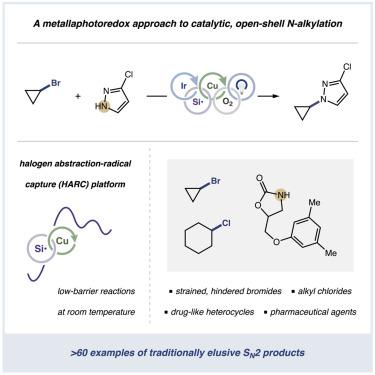Chem ( IF 19.1 ) Pub Date : 2021-06-16 , DOI: 10.1016/j.chempr.2021.05.005 Nathan W Dow 1 , Albert Cabré 1 , David W C MacMillan 1, 2

|
The catalytic union of amides, sulfonamides, anilines, imines, or N-heterocycles with a broad spectrum of electronically and sterically diverse alkyl bromides has been achieved via a visible-light-induced metallaphotoredox platform. The use of a halogen abstraction-radical capture (HARC) mechanism allows for room temperature coupling of C(sp3)-bromides using simple Cu(II) salts, effectively bypassing the prohibitively high barriers typically associated with thermally induced SN2 or SN1 N-alkylation. This regio- and chemoselective protocol is compatible with >10 classes of medicinally relevant N-nucleophiles, including established pharmaceutical agents, in addition to structurally diverse primary, secondary, and tertiary alkyl bromides. Furthermore, the capacity of HARC methodologies to engage conventionally inert coupling partners is highlighted via the union of N-nucleophiles with cyclopropyl bromides and unactivated alkyl chlorides, substrates that are incompatible with nucleophilic substitution pathways. Preliminary mechanistic experiments validate the dual catalytic, open-shell nature of this platform, which enables reactivity previously unattainable in traditional halide-based N-alkylation systems.
中文翻译:

通过铜金属光氧化还原和烷基卤化物的甲硅烷基自由基活化的通用 N-烷基化平台
通过可见光诱导的金属光氧化还原平台实现了酰胺、磺胺、苯胺、亚胺或N-杂环与广谱电子和空间多样化烷基溴的催化结合。卤素提取-自由基捕获 (HARC) 机制的使用允许使用简单的 Cu(II) 盐在室温下耦合 C( sp 3 )-溴化物,有效绕过通常与热诱导 S N 2 或 S相关的过高障碍N 1 N-烷基化。这种区域和化学选择性方案与 >10 类药物相关的N兼容- 亲核试剂,包括已建立的药剂,以及结构多样的伯、仲和叔烷基溴。此外,通过将N-亲核试剂与环丙基溴和未活化的烷基氯(与亲核取代途径不相容的底物)结合,突出了 HARC 方法与传统惰性偶联伙伴结合的能力。初步的机械实验验证了该平台的双重催化、开壳性质,这使得在传统的基于卤化物的N-烷基化系统中无法实现的反应性成为可能。











































 京公网安备 11010802027423号
京公网安备 11010802027423号